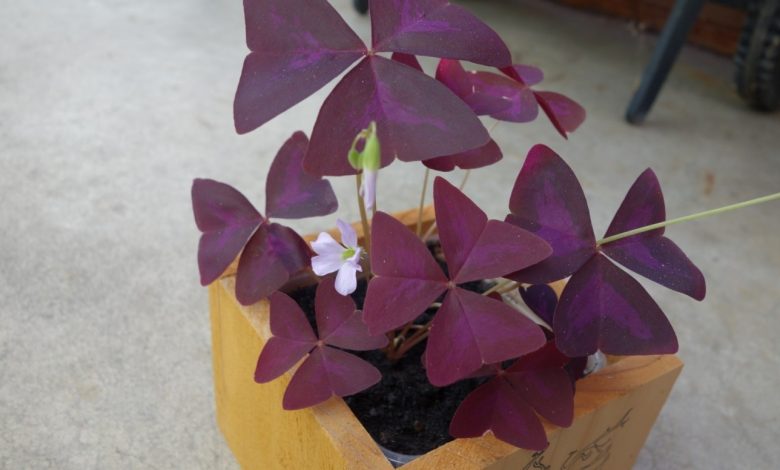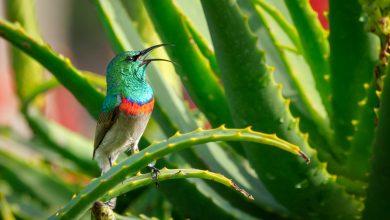How to Grow Purple Shamrock (Black Oxalis Triangularis)

Also known as Purple Shamrock, the Oxalis triangularis is a ground growing, bulbous, and perennial plant native to Brazil and other parts of South America. The plant has an average height of 12 inches. It’s a member of the Oxalidaceae family, known for having divided leaves that close up at night or in low light.
The Oxalis triangularis is also called false shamrock and love plant, all on account of the color and shape of its leaves, which are deep purple with triangular leaflets.
This plant will do well either as an indoor or outdoor plant, provided the conditions are favorable. As an outdoor plant, the purple shamrock may be an invasive weed. Still, the roots and leaves of the false shamrock are edible, the purple foliage often serving as a dressing for salads
The purple shamrock is famous as a houseplant, due to the color and shape of its foliage. These features are unmistakable in any space you find the flower. The following is a guide on how to grow the purple shamrock.
Caring for Oxalis Triangularis
Soil, water, light, and dormancy periods are major areas of interest in this plant’s care.
Soil Requirements
Oxalis triangularis thrives in well-drained and aerated soils. Heavy soils that retain water will cause the bulbs and roots of the plant to rot. Standard potting mixtures will work well for the plant, but ensure that it’s not one that retains water.
Watering
The purple shamrock doesn’t like too much water, as it can survive for extended periods without it, especially in cold weather. The soil should consistently remain moist but not so wet that you can see water on the surface of the soil.
There are ways to tell how often to water houseplants. One such way is to push a finger into the soil and only water if the finger comes out dry. In fall and winter, when the plant experiences no active growth, you may water the plant once every other week.
Light Requirements
Oxalis triangularis is not a low light house plant; as such, position the plant such that it receives ample light. Insufficient light will hamper the growth of the plant and may cause it to appear leggy. A south-facing window offers the best lighting, while north-facing windows provide next to no sunlight. In the absence of a south-facing window, east or west-facing windows may suffice.
The purple leaves of the plant are light-sensitive, and in a process referred to as photonasty, they turn towards light sources and will open to their fullest with bright light. Partially closed leaves are an indication that the plant is not getting enough light. You can augment poor lighting by taking the plant outside for a few hours. Too much sun can burn the foliage, so limit sun exposure.
Humidity
Unlike many house plants, such as the Hindu rope plant, purple shamrocks do not demand much humidity. Average household humidity is enough for this plant. If the air in the room is excessively dry as a result of central heating or climate control, you may use a humidifier or pebble and water tray to improve humidity.
Fertilizing
Like with watering, cut back on fertilizing the plant in the fall and winter. In summer through spring, when the plant is experiencing active growth, apply a balanced and diluted liquid fertilizer once in two weeks.
With continued fertilizer application, salts may build up in the potting soil, resulting in burned leaves. To get rid of the excess salt, flush the soil by allowing water to flow through it and out of the drain holes.

Flowering
The oxalis triangularis is famous for its purple foliage and not its flowers. Still, the plant produces white, trumpet-like flowers with a tinge of purple. The flowers will remain on the plant for a few weeks, growing in clusters slightly above the purple leaves.
The flowers bloom mostly in the summer, as there is more light and warmth available. Still, they can bloom anytime in the right light and temperature. It is best to trim off the flowers as they start to die, else they will dry out before falling off and make for a messy looking plant.
Temperature
The ideal temperature for the purple shamrock is between 65 to 75 degrees Fahrenheit. Under a higher temperature than this, the foliage will begin to wilt. In the cold season, position the plant away from artificial heat sources. Fifty degrees Fahrenheit is the allowable minimum temperature for most house plants, including Oxalis triangularis.
Pruning
The purple leaves will start to drop after the growth period, as the plant enters into dormancy. At this point, you may cut off what vegetation that remains. Other than this, the plant does not require much pruning.
Dormancy Care
Typically, after summer and in months of active growth, the leaves on the Oxalis may become dry and start to turn brown. These changes in the plant are not signs of illness, but indications that the plant is going into its dormancy phase.
Temperatures exceeding 80 degrees Fahrenheit can also trigger dormancy. In outdoor purple shamrock plants, dormancy is more easily predicted than for indoor plants, as the plant may experience several periods of growth before becoming dormant.
During dormancy, water the plant less frequently and allow the browning leaves to fall off or dry out before trimming them. Relocate the plant to a cold and dark place and give it two to four weeks of rest.
After four weeks, move the plant to its original position or an area with sufficient light. Water the plant and apply fertilizer as you would typically do to encourage regrowth.
Toxicity
Although the purple shamrock is edible and people have consumed the plant for years, it can be poisonous to animals. As such, keep the plant away from pets.
Diseases
The Oxalis triangularis is, to a large extent, free from any severe diseases. Root rot, the result of overwatering or soils with poor drainage, can cause severe problems for the plant.
Signs of root rot are black and softened bulbs in the soil and limpness of the plant. When decay occurs, it is best to dispose of the plant, as the disease will lead to the eventual death of the plant. If the soil is the cause of the problem, change it before planting a new bulb, and ensure that there are holes at the bottom of the container and give it less water.
Other than root rot, fungal diseases, such as leaf spot/rust and powdery mildew, arising from excessive amounts of humidity and poor light may affect the plant.
Leaf Rust/Spot
Leaf rust comes up as yellow streaks appearing on the leaves. Leaf spot manifests as red, tan, brown, or black spots on the leaves. The foliage may eventually turn yellow and drop.
Leaf spot is frequently an aesthetic problem and can be handled by cutting off the affected leaves and relocating the plant to a warmer and brighter place. If the disease persists, use a fungicide as per the instructions on the label.
Powdery Mildew
This disease appears as white patches on the entire plant. Consequently, the leaves may turn yellow and fall off, as powdery mildew leeches nutrients from the stems and impairs its ability to photosynthesize.
Similar to leaf spot, powdery mildew is a fungal disease, the primary culprit being humidity. Remediation is the same as with leaf rust/spot.
Pests
Spider mites and mealybugs are the primary pests of the purple shamrock. In extreme cases and if left unattended, these pests will kill the plant and likely spread to other house plants.
Spider mites spin delicate webs over the Oxalis while sucking its sap, and mealybugs resemble white cotton-like materials but are congregating tiny insects.

Potting
While planting purple shamrock bulbs, ensure that whatever container you use has holes at the bottom to allow easy drainage. Also, make sure the soil won’t retain water to the extent of being soggy. Follow the steps below to pot Oxalis triangularis.
- Fill three-quarters of the pot with suitable potting soil and water it.
- Depending on the size of the pot, place two to three bulbs on the soil.
- Cover the bulbs with one and a half inches of soil.
- Water the soil again until water flows out of the holes in the container
- Position the pot in a place with sufficient bright light and expect to see sprouts in two to three weeks.
Repotting
Purple shamrocks grow to about one foot all around. As such, repotting is only necessary to change the soil or grow new plants from the offsets that have developed. It’s best to repot the plant in winter when the plant is dormant. The steps for repotting are the same as for potting.
Propagation
By fall, the bulbs would have multiplied in the soil. Propagate the Oxalis triangularis by repotting the offsets to create new plants. It’s always better to propagate the plant while it’s in its dormant state. To grow fresh purple shamrocks, take the plant out of the pot and carefully separate the bulbs, planting them in new pots.
Allow the leaves to die off entirely before you attempt to propagate. Do not cut off the dying leaves while it still has some color. It’s likely the bulbs have not finished gathering nutrients, and prematurely trimmed foliage will result in weak bulbs and, by extension, weak plants.



